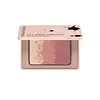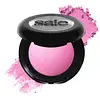What's inside
What's inside
 Key Ingredients
Key Ingredients

 Benefits
Benefits

 Concerns
Concerns

 Ingredients Side-by-side
Ingredients Side-by-side

Mica
Cosmetic ColorantPentaerythrityl Tetraisostearate
EmollientHydrogenated Vegetable Oil
EmollientCI 77891
Cosmetic ColorantOctyldodecyl Stearoyl Stearate
EmollientCI 77491
Cosmetic ColorantAluminum Starch Octenylsuccinate
AbsorbentSilica
AbrasiveCI 77499
Cosmetic ColorantHydrogenated Polyisobutene
EmollientCaprylyl Glycol
EmollientEthylhexylglycerin
Skin ConditioningCaprylic/Capric Triglyceride
MaskingAluminum Hydroxide
EmollientCI 15850
Cosmetic ColorantLauroyl Lysine
Skin ConditioningEthylene/Propylene/Styrene Copolymer
Pentaerythrityl Tetra-Di-T-Butyl Hydroxyhydrocinnamate
AntioxidantSorbitan Tristearate
EmulsifyingButylene/Ethylene/Styrene Copolymer
Tocopherol
AntioxidantCI 77492
Cosmetic ColorantCI 77007
Cosmetic ColorantKaolin
AbrasiveTalc
AbrasiveAlumina
AbrasiveSynthetic Fluorphlogopite
Diisostearyl Malate
EmollientHydrogenated Castor Oil Hydroxystearate
Skin ConditioningTin Oxide
AbrasiveSoybean Glycerides
EmollientButyrospermum Parkii Butter Unsaponifiables
Skin ConditioningZinc Stearate
Cosmetic ColorantAscorbyl Palmitate
AntioxidantMica, Pentaerythrityl Tetraisostearate, Hydrogenated Vegetable Oil, CI 77891, Octyldodecyl Stearoyl Stearate, CI 77491, Aluminum Starch Octenylsuccinate, Silica, CI 77499, Hydrogenated Polyisobutene, Caprylyl Glycol, Ethylhexylglycerin, Caprylic/Capric Triglyceride, Aluminum Hydroxide, CI 15850, Lauroyl Lysine, Ethylene/Propylene/Styrene Copolymer, Pentaerythrityl Tetra-Di-T-Butyl Hydroxyhydrocinnamate, Sorbitan Tristearate, Butylene/Ethylene/Styrene Copolymer, Tocopherol, CI 77492, CI 77007, Kaolin, Talc, Alumina, Synthetic Fluorphlogopite, Diisostearyl Malate, Hydrogenated Castor Oil Hydroxystearate, Tin Oxide, Soybean Glycerides, Butyrospermum Parkii Butter Unsaponifiables, Zinc Stearate, Ascorbyl Palmitate
Mica
Cosmetic ColorantSynthetic Fluorphlogopite
Kaolin
AbrasiveSqualane
EmollientJojoba Esters
EmollientOctyldodecanol
EmollientHectorite
AbsorbentSilica
AbrasiveEthylhexylglycerin
Skin ConditioningPotassium Sorbate
PreservativeAlumina
AbrasiveBoron Nitride
AbsorbentCellulose
AbsorbentTin Oxide
AbrasiveGlycerin
HumectantSodium Acetylated Hyaluronate
HumectantWater
Skin ConditioningTocopherol
AntioxidantGlycyrrhiza Glabra Root Extract
BleachingSodium Benzoate
MaskingCI 77891
Cosmetic ColorantIron Oxides
CI 77163
Cosmetic ColorantCI 77007
Cosmetic ColorantCI 15850
Cosmetic ColorantMica, Synthetic Fluorphlogopite, Kaolin, Squalane, Jojoba Esters, Octyldodecanol, Hectorite, Silica, Ethylhexylglycerin, Potassium Sorbate, Alumina, Boron Nitride, Cellulose, Tin Oxide, Glycerin, Sodium Acetylated Hyaluronate, Water, Tocopherol, Glycyrrhiza Glabra Root Extract, Sodium Benzoate, CI 77891, Iron Oxides, CI 77163, CI 77007, CI 15850
 Reviews
Reviews

Ingredients Explained
These ingredients are found in both products.
Ingredients higher up in an ingredient list are typically present in a larger amount.
Alumina is another name for the compound aluminum oxide. It is used as a thickener, absorbent, and abrasive.
As an absorbent, alumina can give a mattifying effect. It is used in mineral sunscreens to help coat nano-sized filters, such as titanium dioxide. By increasing the size of the UV filters, these ingredients stay on the skin for a longer time. By coating small sized ingredients, alumina helps thicken a product.
Alumina may be used as an abrasive, or exfoliant.
Alumina is naturally occurring in the mineral corundum. Certain varieties of corundum create rubies and sapphires. Corundum is also the crystalline form of alumina.
Learn more about AluminaCi 15850 is the pigment color red. It is an azo dye and created synthetically.
Azo dyes need to be thoroughly purified before use. This allows them to be more stable and longer-lasting.
This ingredient is common in foundations, lipsticks, and blushes. This color is described as brown/orangey red.
It has many secondary names such as Red 6 and Red 7. According to a manufacturer, Red 6 usually contains aluminum.
Learn more about CI 15850This pigment is called Ultramarine blue lazurite. It gives a saturated blue color, but can be used to create other colors as well.
According to the manufacturer, it is usually made from kaolin, sodium sulfate, sodium carbonate, sulfur, and charcoal.
Ci 77891 is a white pigment from Titanium dioxide. It is naturally found in minerals such as rutile and ilmenite.
It's main function is to add a white color to cosmetics. It can also be mixed with other colors to create different shades.
Ci 77891 is commonly found in sunscreens due to its ability to block UV rays.
Learn more about CI 77891Ethylhexylglycerin (we can't pronounce this either) is commonly used as a preservative and skin softener. It is derived from glyceryl.
You might see Ethylhexylglycerin often paired with other preservatives such as phenoxyethanol. Ethylhexylglycerin has been found to increase the effectiveness of these other preservatives.
Kaolin is a clay. It is used for oil control and to help minimize pores. Like other clays, kaolin has the ability to absorb excess sebum or oil. This can help clean out pores and mattify the skin.
Some types of kaolin may have exfoliating properties. When water is added to kaolin, it becomes a paste with small abrasive particles.
Most kaolin is a white color, but may be pink/orange/red depending on where it comes from.
The name 'kaolin' comes from a Chinese village named 'Gaoling'. Kaolin clay comes from rocks rich in kaolinite. Kaolinite, the mineral, has a silicate layered structure. Kaolinite is formed from chemical weathering of aluminum siilicate minerals.
Besides skincare, kaolin is commonly used to make glossy paper, in ceramics, toothpaste, and as medicine to soothe stomach issues.
Learn more about KaolinMica is a naturally occurring mineral used to add shimmer and color in cosmetics. It can also help improve the texture of a product or give it an opaque, white/silver color.
Serecite is the name for very fine but ragged grains of mica.
This ingredient is often coated with metal oxides like titanium dioxide. Trace amounts of heavy metals may be found in mica, but these metals are not harmful in our personal products.
Mica has been used since prehistoric times throughout the world. Ancient Egyptian, Indian, Greek, Roman, Aztec, and Chinese civilizations have used mica.
Learn more about MicaSilica, also known as silicon dioxide, is a naturally occurring mineral. It is used as a fine, spherical, and porous powder in cosmetics.
Though it has exfoliant properties, the function of silica varies depending on the product.
The unique structure of silica enhances the spreadability and adds smoothness, making it a great texture enhancer.
It is also used as an active carrier, emulsifier, and mattifier due to its ability to absorb excess oil.
In some products, tiny microneedles called spicules are made from silica or hydrolyzed sponge. When you rub them in, they lightly polish away dead skin layers and enhance the penetration of active ingredients.
Learn more about SilicaSynthetic Fluorphlogopite is the synthethic version of mica. It consists of fluorine, aluminum and silicate.
Synthetic Fluorphlogopite is used to add volume to products.
It is considered non-irritating on the skin.
Learn more about Synthetic FluorphlogopiteTin Oxide is an inorganic oxide used to add opacity and volume to a product. In nature, it is already found in mineral form. The main ore of tin is an opaque and shiny mineral called casseterite.
Tin Oxide helps remove translucency in a product, or make it more opaque. Besides adding opacity, tin oxide is used for bulking to add volume.
Tocopherol (also known as Vitamin E) is a common antioxidant used to help protect the skin from free-radicals and strengthen the skin barrier. It's also fat soluble - this means our skin is great at absorbing it.
Vitamin E also helps keep your natural skin lipids healthy. Your lipid skin barrier naturally consists of lipids, ceramides, and fatty acids. Vitamin E offers extra protection for your skin’s lipid barrier, keeping your skin healthy and nourished.
Another benefit is a bit of UV protection. Vitamin E helps reduce the damage caused by UVB rays. (It should not replace your sunscreen). Combining it with Vitamin C can decrease sunburned cells and hyperpigmentation after UV exposure.
You might have noticed Vitamin E + C often paired together. This is because it is great at stabilizing Vitamin C. Using the two together helps increase the effectiveness of both ingredients.
There are often claims that Vitamin E can reduce/prevent scarring, but these claims haven't been confirmed by scientific research.
Learn more about Tocopherol